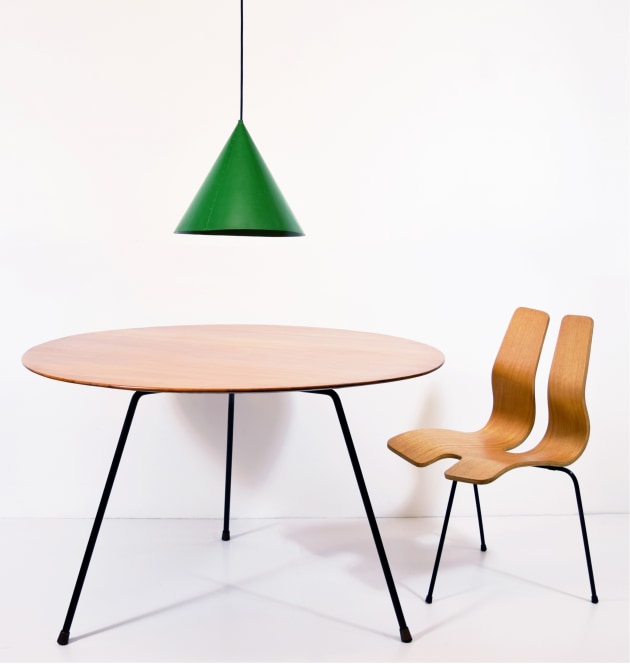Clement Meadmore, a pioneering figure of Australian modernist design
Clement Meadmore, Pendant Light for the T House 1956, Three-legged Dining Table 1955, Three-legged Plywood Chair 1955, Harris/Atkins Collection. Image courtesy TarraWarra Museum of Art
Clement Meadmore (1929–2005) was known for his outdoor steel sculpture, and also for his modernist furniture, notably chairs. Born in Australia, he studied engineering and industrial design, and in 1963 relocated to New York City where he taught sculpture. His work is represented in public galleries and museums in the USA and Australia. As well as The Modern Chair and other books, he also authored How to Make Furniture without Tools. The latter was about using pre-cut plywood and glue.

Clement Meadmore, Side Table 1954, Reverse Cantilever Chair 1954, Corded Chair 1951, Chair for the Legend Espresso and Milk Bar 1955, Harris/Atkins Collection. Image courtesy TarraWarra Museum of Art
On 23 March, TarraWarra Museum of Art unveiled three new exhibitions open to the public concurrently until 14 July 2024. Featuring new work by Melbourne-based contemporary artists Peter Atkins and Dana Harris, the exhibition SUPERsystems is presented in conversation with The Industrial Design of Clement Meadmore: The Harris/Atkins Collection, a comprehensive survey of innovative modernist designs by the acclaimed sculptor and designer Clement Meadmore. Also on display is Systems and Structures, featuring a selection of works by leading Australian artists drawn from the Museum’s collection.
Widely regarded as one of Australia’s most important sculptors of the twentieth century, Clement Meadmore is also acknowledged as a significant and pioneering figure within the history of Australian modernist design.
Featuring an extensive group of individual pieces from the 1950s and early 1960s, The Industrial Design of Clement Meadmore highlights Meadmore’s highly distinctive approach to industrial design and his remarkable ability to manipulate the most basic, readily available materials—steel rod, cotton cord, glass, sheet metal, canvas and thin plywood—into functional, innovative and durable objects.

Clement Meadmore, Glass-top Coffee Table 1962, painted steel, glass and rubber; Wire Chair (model DC601A) c. 1958 (co-designer Michael Hirst), plastic-coated steel, vinyl and rubber, Harris/Atkins Collection. Images courtesy TarraWarra Museum of Art
Meticulously assembled by the artists Peter Atkins and Dana Harris over the past 25 years, this exemplary collection of Meadmore’s iconic chairs, tables and lighting is the most important and comprehensive collection of his industrial design in public or private hands. Presented for the first time in its entirety, the Harris/Atkins Collection provides a unique opportunity to survey the breadth and depth of Meadmore’s singular design language.
If you visit from Saturday 4 to Sunday 5 May you’ll also catch the 2024 TarraWarra Festival which this year see Richard Tognetti and the Australian Chamber Orchestra perform in the central gallery, in response to the Systems and Structures exhibition that will surround the audience and Orchestra.
Established in 2003, TarraWarra Museum of Art presents a changing exhibition program of twentieth and twenty-first century art, creating dynamic and memorable experiences for all audiences and encouraging curiosity and creativity within the wider community. The museum is located in Healesville, Victoria and has a collection of over 700 works of twentieth and twenty-first century Australian art.
See TarraWarra Museum of Art, Wurundjeri Country, 313 Healesville-Yarra Glen Road, Healesville, Vic 3777



